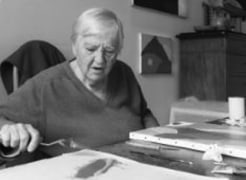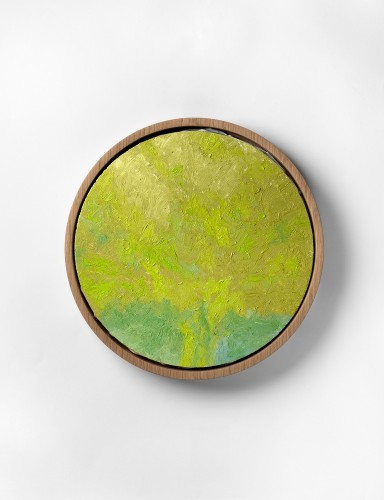

Etel Adnan, Olivéa : Hommage à la Déesse de l'Olivier, 2018.
“Why not think about places in relation to their potential as voids rather than as solids?
How can we fight fear of emptiness in architecture?
How can we imagine forms that generate places of silence and contemplation?”
Hala Wardé
For the Lebanese Pavilion at the 17th Venice Architecture Biennale, Hala Wardé, the architect and founder of HW Architecture, who realized the Louvre Abu Dhabi with Jean Nouvel, presents A Roof for Silence.
Selected in the first public competition launched by the Lebanese authorities to represent Lebanon, Hala Wardé's proposal was chosen by a committee of experts appointed by the Ministry of Culture and the Federation of Lebanese Engineers and Architects, presided by Jad Tabet. Echoing the question “How will we live together?” as raised by Hashim Sarkis, Hala Wardé tackles the issue of coexistence through a questioning of the spaces of silence, and by putting into dialogue architecture, painting, music, poetry, video and photography.
The Lebanese Pavilion is conceived as a musical score, resonating disciplines, shapes and periods to provoke the sensory experience of a thought, articulated around the notions of emptiness and silence, as temporal and spatial conditions of architecture. A “revelationary” installation, as per Paul Virilio's definition, in tribute to the renowned thinker and urbanist.
Treated as a manifesto for a new form of architecture, Hala Wardé's project is based on the cryptic shapes of a group of sixteen olive trees that are a thousand years old in Lebanon. These legendary trees, whose hollowed forms are home to various species, are the tutelary figure of the Lebanese Pavilion. They are places of recollection or gathering, where peasants have convened for generations to decide on village affairs or to celebrate weddings.
Questioning the territorial and urbanistic approach to emptiness, Hala Wardé's architectural project starts off with the “Antiforms” of Paul Virilio, theorist of the acceleration of time and the disintegration of territories. The project explores resonance between Paul Virilio's paintings, spaces of in-between, and the graphic representation of the olive trees, as well as the imprint of the sudden Port of Beirut explosion on August 4, 2020. It finds its centrepiece in a central room, the highest point of the experience, conceived around an artwork by the poet and artist Etel Adnan: a set of sixteen canvases entitled Olivéa: Hommage à la Déesse de l’Olivier.
A Roof for Silence, which will be unveiled for the first time at the 17th Venice Architecture Biennale, will continue its cultural itinerary in different cities around the world. As a first step, it will be the subject of a temporary exhibition at the National Museum of Beirut, during the inauguration of its new wing built by the Fondation Nationale du Patrimoine for the promotion of architectural and artistic heritage. It will then be presented at the Palais de Tokyo in Paris.
Finally, the project has a social and heritage dimension. Initiatives and mobilization campaigns will be organized within the context of the Biennale to raise awareness among the public and the international community of experts and architects about the rehabilitation of the damaged architectural and cultural heritage of the city of Beirut.
The Lebanese Pavilion will thus offer its platform to the Beirut Heritage Initiative, an independent and inclusive collective created after the Beirut blast on August 4, 2020, to restore the built and cultural heritage of the city.